Fleshly Impressions: The Work of Paddy Hartley
Paddy Hartley
Corsetry, like many other modificatory practices, is far from new. In fact images of corsetry dating from around 9500 BC have been found at the Neolithic site at Brandon in England. Evidence of the use of corsets to mould the bodies of young Minoan females and males has also been discovered by archaeologists working in Crete, and ?girdles? and ?stomachers? are mentioned in the Book of Isaiah in the Old Testament. These are just a few of a plethora of examples of practices which involve the sculpting of bodies in historically and culturally specific ways. In the current context of Western consumer capitalism modificatory practices and procedures abound: from corsetry to liposuction, self-amputation to tattooing, the use of growth hormones to implants of various kinds, phalloplasty to circumcision, and the list goes on, and on, and on.
At the risk of stating the obvious, it seems that a fundamental aspect of human being is the tendency to transform bodies, sometimes intentionally, sometimes not. Given this, I am intrigued by the responses of some to Paddy Hartley?s ?facial corsets?, by the idea that moulding the face in and through the use of such implements is somehow perverse. And indeed, it seems to me that this is one the many questions or conundrums that Hartley?s work at once raises and refuses to answer. If, as the American Society of Aesthetic Plastic Surgery (ASAPS) claims, in 2003 in the USA alone 8.3 million people underwent cosmetic procedures, then why would the temporary modification of the face and head through the use of corsetry appear repugnant? Perhaps it is less the effects of Hartley?s corsets that disturb viewers than the garments themselves, some of which may evoke the spectre of that most feared, six-fingered ?monster? Hannibal Lecter who, of course, was smitten with the skins of those whose bodies he gratuitously modified. But then again, perhaps as Denna Jones has noted, insofar as these facial second skins ?activate - when pulled, cinched or tied-off - an articulation of the ever-shifting loyalties of fashion for particular shapes, styles, zones of preference, they could be said to graphically illustrate both the seductiveness and the dangers of (im)permanence. Ultimately, what is perhaps most interesting about these images is their capacity to move the viewer, to mark him or her in inestimable ways.
It is also worth noting here, that since September 2003, Hartley?s practice has developed a separate and significant strand. In and through his work with Dr Ian Thompson in the Department of Oral Maxillofacial surgery at King?s College, London, Hartley has modified the basic face corset design to incorporate biomaterials for the treatment of skeletal facial conditions. Amongst other things, this shift in Hartley?s work poignantly undermines the alleged distinction between art and science, and between ?cosmetic? procedures and ?reconstructive? ones.
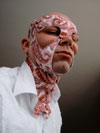 |
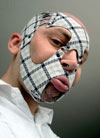 |
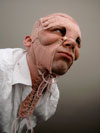 |
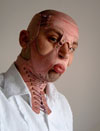 |
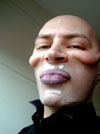 |
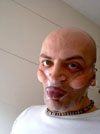 |
| Click an image for full-sized version | ||